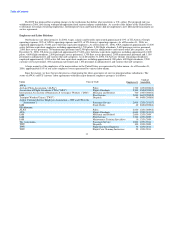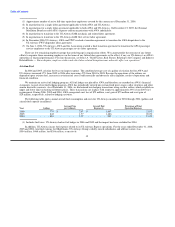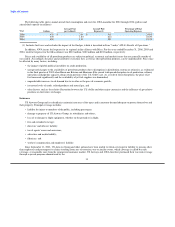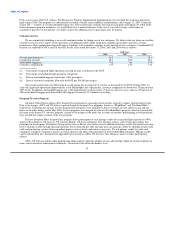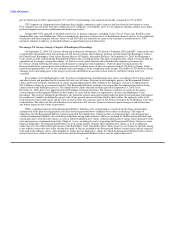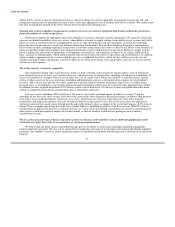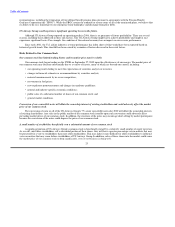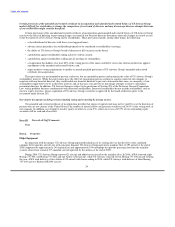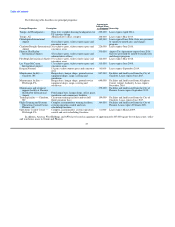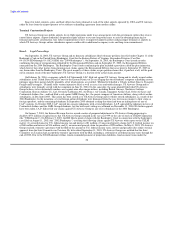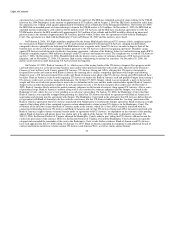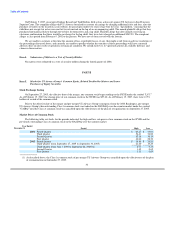US Airways 2006 Annual Report Download - page 24
Download and view the complete annual report
Please find page 24 of the 2006 US Airways annual report below. You can navigate through the pages in the report by either clicking on the pages listed below, or by using the keyword search tool below to find specific information within the annual report.
Table of Contents
ability of U.S. carriers to operate international routes is subject to change because the applicable arrangements between the U.S. and
foreign governments may be amended from time to time, or because appropriate slots or facilities may not be available. We cannot assure
that laws or regulations enacted in the future will not adversely affect our operating costs.
Ongoing data security compliance requirements could increase our costs and any significant data breach could harm our business,
financial condition or results of operations.
Our business requires the appropriate and secure utilization of customer and other sensitive information. We cannot be certain that
advances in criminal capabilities, discovery of new vulnerabilities, attempts to exploit existing vulnerabilities in our systems, data thefts,
physical system or network break-ins or inappropriate access, or other developments will not compromise or breach the technology
protecting the networks that access and store database information. Furthermore, there has been heightened legislative and regulatory
focus on data security, including requiring varying levels of customer notification in the event of a data breach. Many of our commercial
partners, including credit card companies, have imposed certain data security standards that we must meet. Failure to comply with the
privacy and data use and security requirements of our partners or related laws and regulations to which we are subject could result in
fines, sanctions or other penalties, which could materially and adversely affect our results of operations and overall business. In addition,
failure to address appropriately these issues could also give rise to additional legal risks, which, in turn, could increase the size and
number of litigation claims and damages asserted or subject us to enforcement actions, fines and penalties and cause us to incur further
related costs and expenses.
The airline industry is intensely competitive.
Our competitors include other major domestic airlines as well as foreign, regional and new entrant airlines, some of which have
more financial resources or lower cost structures than ours, and other forms of transportation, including rail and private automobiles. In
many of our markets we compete with at least one other low-cost air carrier. Our revenues are sensitive to numerous factors, and the
actions of other carriers in the areas of pricing, scheduling and promotions can have a substantial adverse impact on overall industry
revenues. These factors may become even more significant in periods when the industry experiences large losses, as airlines under
financial stress, or in bankruptcy, may institute pricing structures intended to achieve near-term survival rather than long-term viability.
In addition, because a significant portion of US Airways' traffic is short-haul travel, US Airways is more susceptible than other major
airlines to competition from surface transportation such as automobiles and trains.
Low cost carriers (including AWA and the new US Airways) have had a profound impact on industry revenues. Using the
advantage of low unit costs, these carriers offer lower fares, particularly those targeted at business passengers, in order to shift demand
from larger, more-established airlines. Some low cost carriers, which have cost structures lower than ours, have better financial
performance and significant numbers of aircraft on order for delivery in the next few years. These low-cost carriers are expected to
continue to increase their market share through growth and could continue to have an impact on the overall performance of US Airways
Group. There is ongoing speculation that some type of airline industry consolidation could occur in the near-term. While US Airways
Group intends to aggressively protect its corporate interests, we cannot assure that through consolidation or otherwise, combinations of
other carriers would not negatively impact our business model, or that we would or would not be a participant in any industry
consolidation scenario.
The loss of key personnel upon whom we depend to operate our business or the inability to attract additional qualified personnel
could adversely affect the results of our operations or our financial performance.
We believe that our future success will depend in large part on our ability to attract and retain highly qualified management,
technical and other personnel. We may not be successful in retaining key personnel or in attracting and retaining other highly qualified
personnel. Any inability to retain or attract significant numbers of qualified management and other personnel could adversely affect our
business.
21


